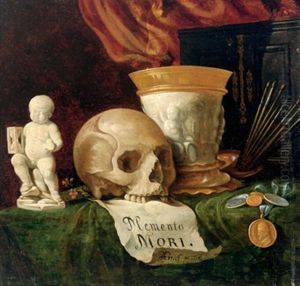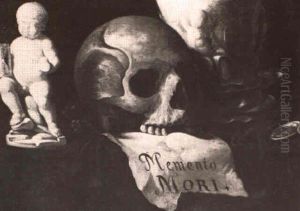Johann Andreas Graff Paintings
Johann Andreas Graff was a German painter, draughtsman, and engraver who was born in Nuremberg in 1636. His artistic career is often associated with the Baroque period, a time characterized by exuberant detail, deep color, and a sense of movement. He was not only a notable artist of his era but also the husband of Maria Sibylla Merian, a distinguished naturalist and scientific illustrator.
Graff received his primary artistic training in his hometown of Nuremberg, which was a significant center for arts and crafts during the 17th century. The city had a long-standing tradition in printmaking, and many artists from there were also skilled engravers. Graff's early works are indicative of the strong influence of his Nuremberg background, often showcasing precise line work and attention to detail. He worked with various mediums but was especially proficient in engraving and etching.
In 1665, Graff married Maria Sibylla Merian, who was the stepdaughter of the still-life painter Jacob Marrel. Marrel was Graff's teacher and through this relationship, he became connected to the Merian family, which was well-known for its contributions to the world of art and science. Graff's marriage to Maria Sibylla Merian produced two daughters, Johanna Helena and Dorothea Maria, who also became artists.
Despite his skill, Graff did not achieve the same level of fame as his wife, Maria Sibylla Merian, who gained renown for her detailed illustrations of plants and insects. Merian's work was groundbreaking in the field of entomology and she is often celebrated for her contributions to both art and science. Graff, on the other hand, was primarily known for his work as an engraver and for his role in supporting his wife's artistic endeavors. He is credited with helping her publish her first book of natural illustrations, 'Neues Blumenbuch', in 1675.
In 1668, Graff and his family moved to Frankfurt am Main, where he continued to work and support his family through his art. The couple later separated, with Maria Sibylla Merian moving to Amsterdam and continuing her work, while Graff remained in Germany. After their separation, Graff's artistic output and his historical presence became somewhat overshadowed by the achievements of his wife.
Johann Andreas Graff died in 1701 in Nuremberg. Although his work may not be as well-recognized as that of his contemporaries or his wife, his contributions to the artistic landscape of his time should not be discounted. His engravings and paintings are valuable pieces of the Baroque art movement and provide insight into the cultural and artistic climate of 17th-century Germany.




